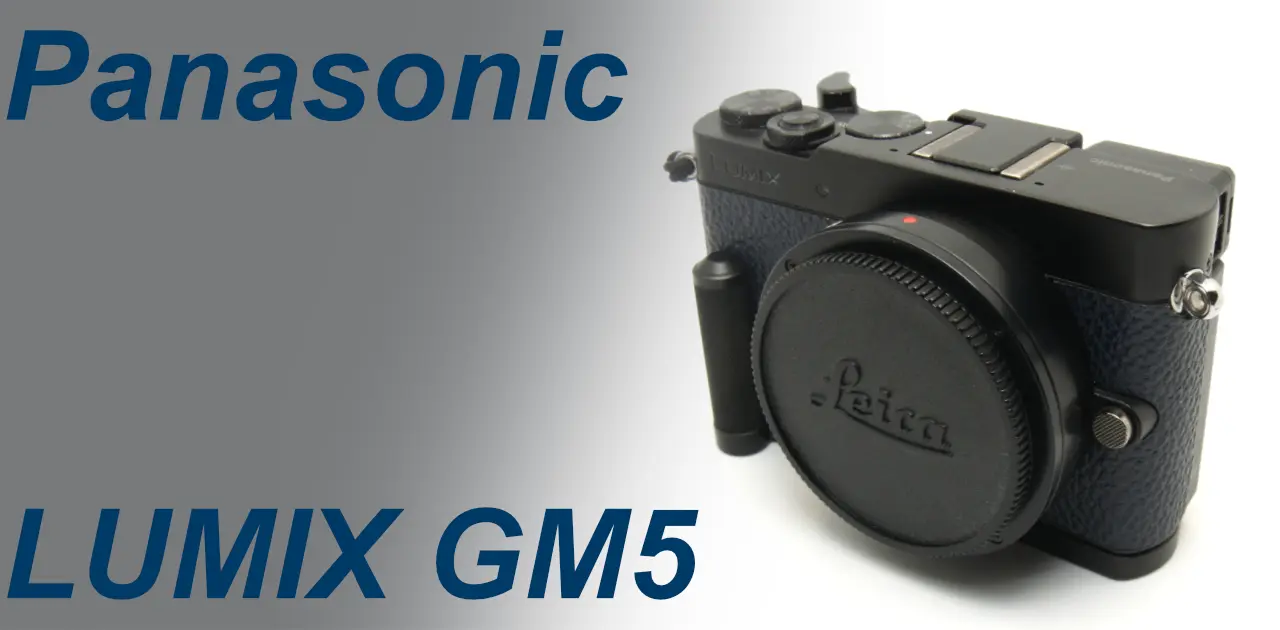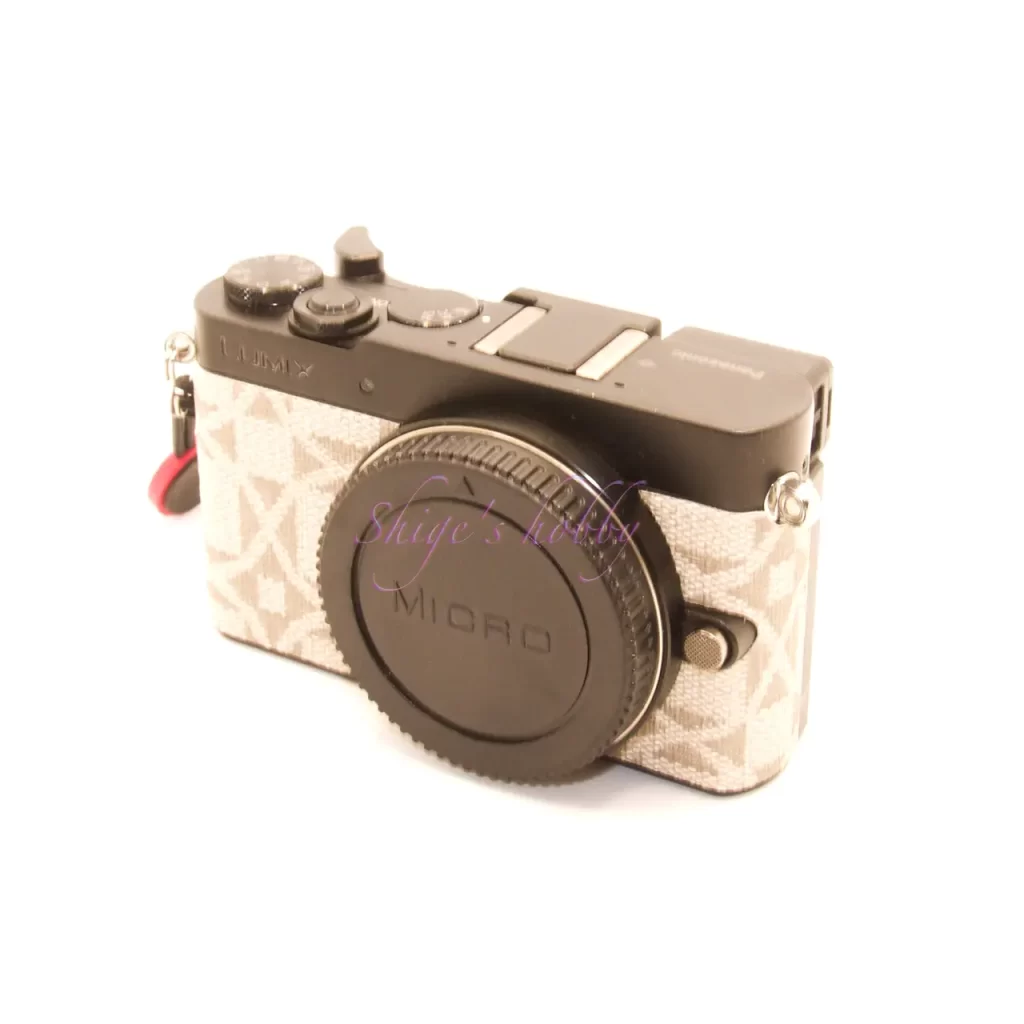The pinnacle of M43: LUMIX GM5

A review and Photo example of the DMC-GM5 digital camera.
Table of contents
Gallery
Review

1.Overview
The LUMIX GM5 was released in 2014 and is a camera that takes the Micro Four Thirds concept to the extreme.
With an EVF fitted to an extremely small body, it’s a product that appeals to a generation for whom a viewfinder is essential for photography.
With an LCD display that stretches all the way to the very edge of the back, from the outside it feels like a return of the MINOLTA CLE.
A 16-megapixel LiveMOS, a 0.2-inch 1.16 million dot EVF, and a 3-inch rear LCD are all packed into a compact body measuring 100mm wide, 60mm high, and 36mm deep. Detailed specifications are listed in the table below.
2.Usage
As of 2024, when I write this, the LUMIX GM5 is a 10-year-old camera. However, it has a 16-megapixel sensor, so I am not dissatisfied with it for everyday use. However, it does not work well with old lenses, and there are times when you can see some questionable colors.
The biggest problem with playing with mount adapters is that if you attach a lens without electronic contacts, you will not be able to use the mechanical shutter. It is silent and quiet when shooting, so there is no problem with most shooting, but if you are not careful and move the camera after shooting, rolling distortion will occur.
I am also a little dissatisfied with the small number of lenses that suit the GM5, and since manual focus is fine, I would enjoy the GM series more if I had a very small lens with a focal length of about 8mm to 12mm.
The widest angle of the lenses I have is the 17mm from Ms-optics (Miyazaki Optical), which is equivalent to a focal length of 34mm in 35mm format. I still want a lens with a focal length of about 24mm in 35mm format.
Kowa’s Prominar lenses come in good focal lengths, 8.5mm and 12mm. However, the lens size is large because they are repurposed from professional lenses, which is a drawback. The Voigtlander NOKTON series also has large lenses, so they do not match well with the GM5.
The original 12-32mm zoom is a bit iffy, and images taken in Raw without correction show the roughness of a compact zoom lens in many places. Other Micro Four Thirds system lenses are often large and heavy, and there are few lenses that match the GM series. In terms of appearance, the Summilux 15mm F1.7 seems to be the best match.
The camera’s controls are cramped, but easy to use, with buttons and dials maximized on the small body. The EVF is a bit rough, but you can check the focus by enlarging it.
Unfortunately, sales of this camera were poor. In 2014, when it was released, the style of taking pictures while looking at a large monitor like a smartphone had become mainstream, and the popularity of compact interchangeable lens digital cameras with EVFs was revealed to be very niche. The subsequent PENTAX Q and NIKON 1 also failed, proving that this line had no demand except among enthusiasts.
The minimal + EVF concept of Micro Four Thirds ended with the GM5, and cameras without viewfinders in the GM1 series were released as the GF9, GF10/GF90, but they were discontinued soon after, and cameras with this concept disappeared from the LUMIX product line.
I stopped by the Panasonic booth at GP+ in 2018 with the GM5 hanging from my hand and asked, “Is there a LUMIX GM5-2 (GM5-II)?” I was recommended, “The GF10/GF90 are the same size, so please take this one,” but I was not interested in a camera without a built-in EVF.
The PEN-F from Olympus (now OM Digital Solutions Co., Ltd.) just barely feels like it belongs to this lineage. However, compared to the GM5, the body size (124.8×72.1×37.3 mm width x height x depth) is a size larger.
I understand that it’s a very niche demand, but I hope that a successor to the GM5 will be released that maintains the body size but has 20 megapixels, equivalent to the PEN-F, and an updated EVF with 2 million dots.
The current situation is very disappointing, because a product only matures through continuity.
3.Summary
In conclusion, to sum up the LUMIX GM5, it is a valuable camera with a larger sensor size than the PENTAX Q and NIKON 1 and the ability to change lenses. However, while it was popular with camera enthusiasts, it did not appeal to general users.
If this camera had been released when Micro Four Thirds was introduced and had been steadily improved and upgraded like the FUJIFILM X100, it might have been called a masterpiece from Panasonic. This is a sad example of a mismatch between the release date and the technology.
Side talk of Panasonic’s camera business
As of 2024, Panasonic’s camera business consists of two parts: L-mount and Micro Four Thirds.
The small S-series and inexpensive lenses for the L-mount seem to have sold well, but the high-priced cameras and lenses that are the manufacturer’s main source of income have completely failed. As for Micro Four Thirds, the camera lineup has been narrowed down and it seems that they are leaning towards video use, and there have been almost no new lens releases, so it seems that they are waiting for the right time to stop using Micro Four Thirds.
Objectively speaking, the LUMIX business seems to be a burden for Panasonic, and it is speculated that the end of the LUMIX camera business and separation of the business are being considered within the company. There are precedents for the method of business separation, and OM Digital Solutions (hereinafter referred to as OMD), which was spun out from Olympus, has been in the red for a long time and is full of the sadness of a small capital. As of 2024, the bodies are rehashes of the past, and the lenses are procured from OEM sources, so it is hardly an independent camera manufacturer. It seems difficult to continue in the camera business without the backbone of large capital. It is expected that Lumix will be in a similar situation if it spins out.
Will there be a merger between Lumix and OMD? It’s difficult to say, but if Panasonic were to pay a certain amount of money as severance pay, it would not be a bad idea for the investment company that holds OM shares. However, in the camera business, where competitors are strong, it will be difficult for an alliance of the weak to survive unless they develop a product that sells before the merger and do the groundwork to launch it with a bang when the merger takes place.
There’s no doubt that it’s difficult to create a product that sells in the first place.
The first time LUMIX has been talked about in a long time is when Panasonic’s Executive Vice President of Entertainment & Communications, General Manager of the Imaging Solutions Division (that’s a long title) said at the time of the announcement of the 2024 L-Mount Alliance camera, the LUMIX DC-S9. He continued, “It is people who are knowledgeable about cameras who will be able to understand the advantages of Micro Four Thirds,” and added, “For people with low camera literacy, Micro Four Thirds is difficult to understand.” (Source: BCN+R “The LUMIX S9 with its ‘cold shoes’ tells the story of the struggles and decisions of camera manufacturers”) This caused some criticism, but as an expression, it could be interpreted as an attempt to cause a stir (in fact, it became a bit of a topic and was a success for the media that published it), which is not desirable, but it is an accurate expression of the current situation. Here, if the LUMIX DC-S9 were a model with a Micro Four Thirds sensor, a high-performance EVF, and in-body image stabilization as the successor to the GM series, and the selling price was about 200,000 yen like the LUMIX DC-S9, would sales be expected? If it is an attractive product, it can be sold at 200,000 yen. However, since the GM5 ended in failure 10 years ago at 100,000 yen, it cannot be said that it will not make the same mistake.
In any case, since Panasonic has a history of failure with the GM series in the past, it will be difficult to pass the revival plan of the GM series as a product plan.
It is expected that we will know whether the LUMIX DC-S9 plan will show a certain degree of success from autumn 2024 to the end of the year, so I will keep an eye on the news. It is not even in the top 50 of BCN’s ranking from April 21 to April 27, 2025, which publishes POS data, so it is probably not selling very well.
Specification
| Items | GM5 | GM / GM1 / GM1S | PEN-F |
| Camera effective pixel count | 16 million pixels | ← | 20 million pixels |
| Lens mount | micro four thirds mount | ← | ← |
| Image sensor | 4/3 type Live MOS sensor Total number of pixels: 16.84 million pixels | ← | 4/3 type Live MOS sensor Total number of pixels: approx. 21.77 million pixels |
| Image Stabilization | none | ← | 5 steps |
| EVF | Color LCD live view finder 0.2 type, equivalent to 1.16 million dots | none | Eye-level OLED viewfinder 2.36 million dots |
| Back LCD | 3.0 inch electrostatic touch panel liquid crystal (approximately 920,000 dots) | 3.0 inch electrostatic touch panel liquid crystal (approximately 1,040,000 dots) | 3.0 inch 2-axis movable liquid crystal display |
| Internal flash | なし | あり | なし |
| Battery | DMW-BLH7 | ← | BLN-1 |
| Size W x H x D (mm) | 98.5 × 59.5 × 36.1 | ← | 124.8 x 72.1 x 37.3 |
| Weight(g) | 211 (including main unit, battery, and memory card) | 204g(only body) | 427 (CIPA compliant, including attached rechargeable battery and memory card) |
| Body color | green, red, black | orange, white, black, silver | black, silver |
| Release date | 2014.11 | 2013.10 | 2016.1 |
| Price(Yen/No-tax/only body) | ¥90,000- | ¥70,000- | ¥150,000- |
Options
- Hand grip DMW-HGR1 (Silver / Black)
- Thumb Rest COTTA CT-SRGM001 (Silver / Black)
- Mount Adapter
Reference links
Update history
- 2025.5.7
- 2024.07.14:Update article
- 2024.05.20:Update article
- 2024.03.03:Update article
- 2022.04.12:First draft
Affiliate links
- Leica lens・Ads by Amazon
- LUMIX GM5・Ads by Amazon
